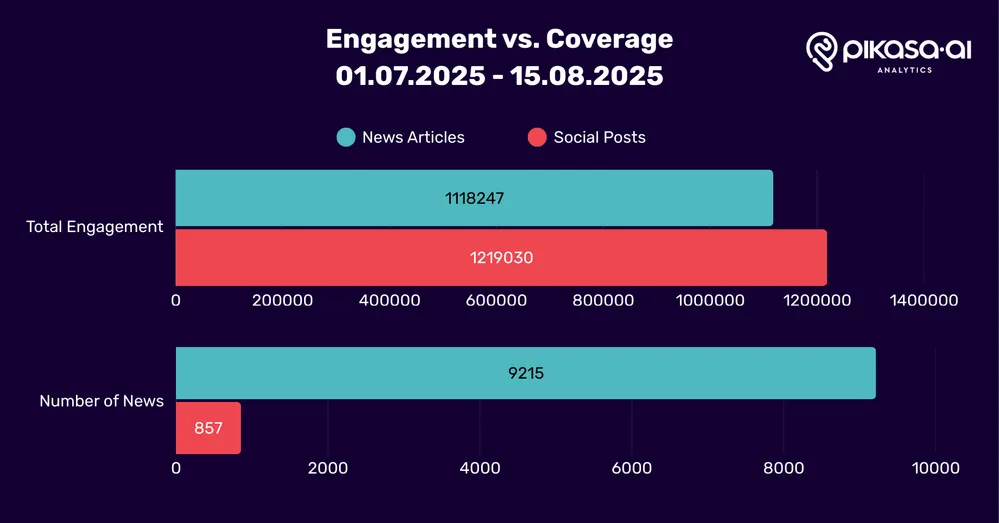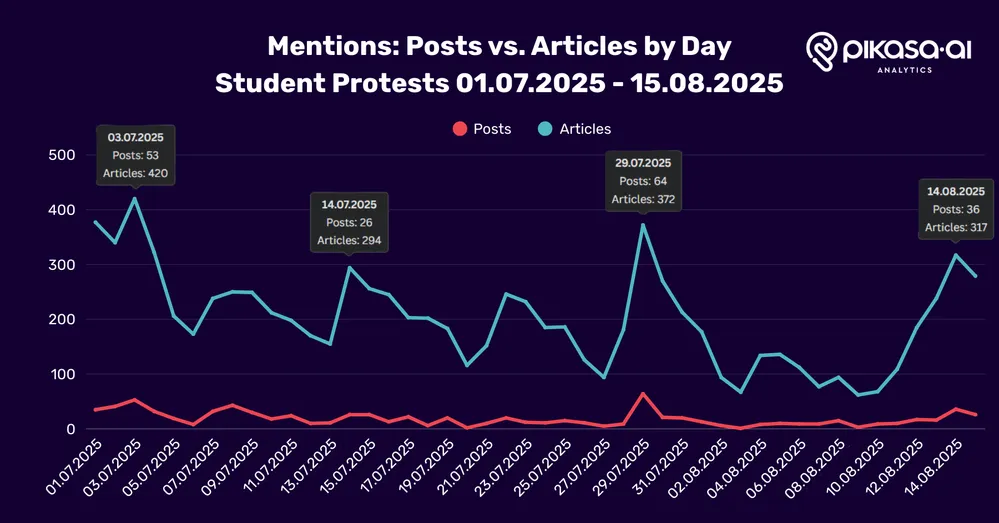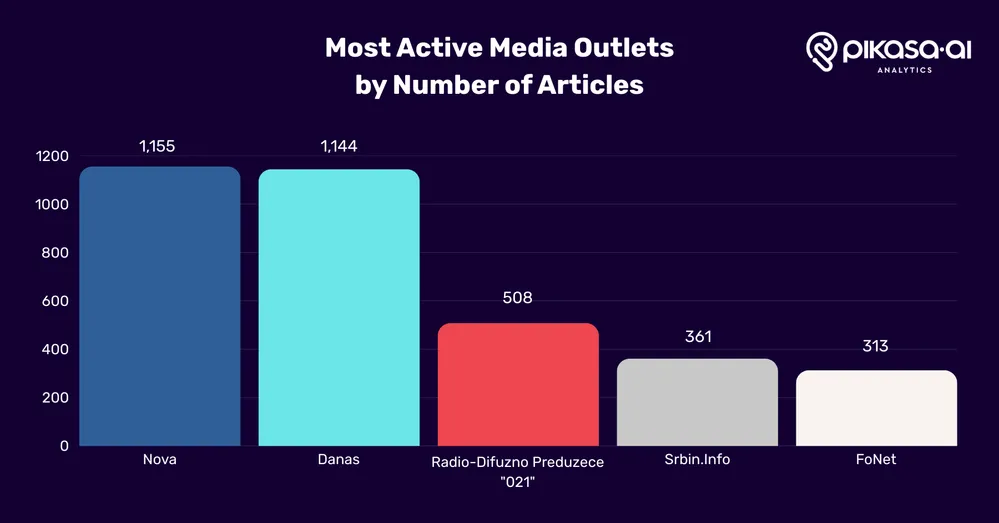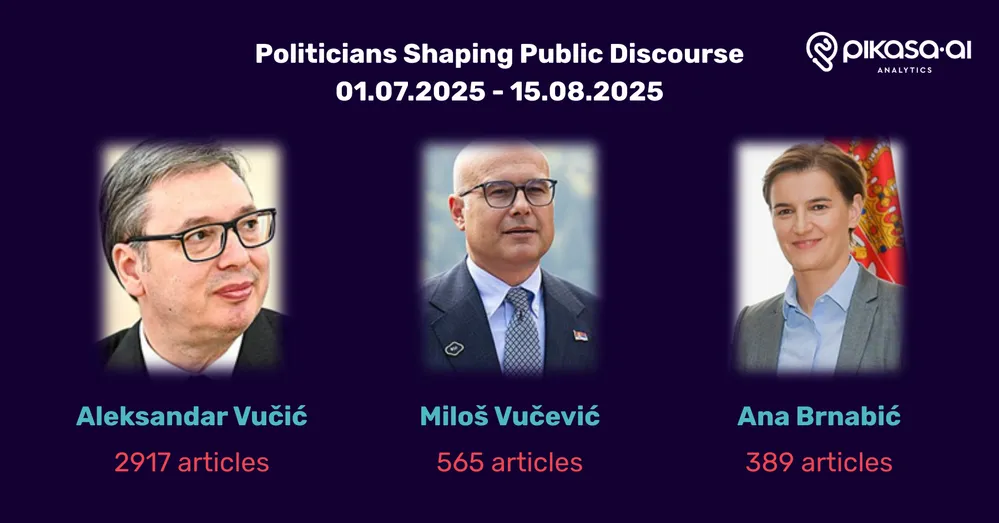Serbia Protests Aug 2025: Pikasa Monitoring Insights
Setting the Stage: Purpose and Approach
Using Pikasa’s media and social media monitoring platform Analytics.live, the Serbia protests can be closely analyzed to understand evolving public discourse and political narratives. Initially focused on demanding accountability for the deaths of 15 people after the canopy collapse in Novi Sad, the movement quickly expanded into broader resistance against governance, corruption, and democratic institutions under President Aleksandar Vučić's administration.
By August, clashes between protesters and police in Belgrade and other cities escalated, resulting in injuries and arrests that fueled nationwide outrage. Media monitoring analytics of the Serbia protests revealed a contested narrative landscape: while certain media outlets framed them as the result of foreign interference and geopolitical conspiracies, others presented them as a legitimate, grassroots response to domestic corruption and authoritarianism.
These insights demonstrate how civil society mobilization in Serbia is shaped by competing media systems producing alternative realities around state response and public activism.
News vs. Networks: Where the Protest Resonated Most
Out of 9,215 news articles on the topic, the total engagement was 1,118,247 - averaging approximately 121 engagements per article. In contrast, only 857 social media posts generated 1,219,030 engagements, averaging about 1,423 engagements per post. Despite accounting for just 8.5% of the total content volume, social media posts drove 52.2% of the total engagement, highlighting their significantly higher impact and reach per item compared to traditional news articles.

Engagement vs. Coverage - Serbia Students Protests 01.07.2025 - 15.08.2025
The Protest Clock: Daily News vs. Social Buzz (Jul-Aug 2025)
Media coverage of the student protests in Serbia peaked on July 3rd with 420 news articles, followed by a secondary peak on July 29th with 372 articles. Social media activity also reached its highest point on July 29th, with 64 posts published. Notably, the peak on July 29th coincides with a police raid on the State University in Novi Pazar, during which students were expelled from the premises.

Mentions: Posts vs. Articles by Day - Serbia Student Protests 01.07.2025 - 15.08.2025
Voices That Shaped the Headlines

Student Protests in Serbia - Most Active Media Outlets by Number of Articles 01.07.2025 - 15.08.2025
Politicians Shaping Public Discourse
Among political figures mentioned in relation to this topic, the Serbian President ranks first with 379,869 engagements. He is followed by Defense Minister Miloš Vučević with 46,766 engagements, and Ana Brnabić with 44,517.

Student Protests in Serbia - Politicians Shaping Public Discourse 01.07.2025 - 15.08.2025
Narratives, Legitimacy, and Political Framing of the Protests
Analysis of the top 500 most engaged Serbian news articles on the student protests reveals a narrative environment dominated by delegitimization frames. Namely, delegitimizing narratives account for 62% of all articles, crowding out alternative framings. This dominance largely reflects the routine quoting of official sources and political figures whose language portrayed protesters as disruptive, dangerous, or externally directed frames that then entered the information stream as reported speech rather than explicit editorial stance.
Within this umbrella, three strands stand out. First, an obstructionism frame - casting students as “blokaderi”/blockers - became the signature trope and positioning protests as a threat to normal life and public order. Second, a violence/security frame - terms like “nasilje,” “teroristi,” and “ekstremisti” reframed civic action as a public-safety problem, legitimizing a tougher state response. Third, foreign-influence claims questioning the protests’ domestic authenticity and tying them to geopolitics.
Supportive framings were marginal (<3%), and “police brutality” or “state violence” appeared rarely in comparison, indicating how agenda access rather than sheer volume of outlets shaped the narrative battlefield.
During this time there was shift in narrative: early July coverage leaned heavily on foreign influence allegations, framing the protests as externally orchestrated. By early August, however, media narratives pivoted toward domestic obstructionism and violence, portraying students as threats to order and security. This transition reflects a strategic adaptation: moving from discrediting the protests’ authenticity to undermining their legitimacy by associating them with chaos and extremism.
Key takeaway: Media’s most-engaged coverage largely defined the protests through order, security, and sovereignty - a framing architecture that narrows public empathy for student demands and normalizes coercive responses, while leaving limited discursive space for rights, accountability, or policy debate.
Why This Analysis Matters: Implications for Policy and Civil Society
Understanding this dynamic is important because it highlights how official discourse and media framing can alter public perception of legitimacy, either undermining or empowering social movements. For policymakers, civil society, and international stakeholders, this type of monitoring provides early-warning signals of escalating political tensions, helps identify coordinated disinformation patterns, and reveals how competing narratives influence citizen trust in institutions. The added value of Pikasa’s analysis lies in its ability to combine quantitative data (coverage, engagement, reach) with qualitative narrative mapping, offering a comprehensive picture of how protests evolve not only on the streets but also across the information space. This dual perspective allows for better-informed strategic responses, whether for advocacy, policy development, or conflict prevention.